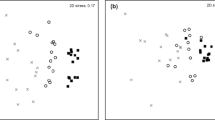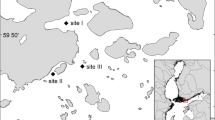Abstract
The Markermeer is a large and shallow man-made freshwater lake in the Netherlands, characterized by its high turbidity. As part of a study aiming to mitigate this high turbidity, we studied the water–bed exchange processes of the lake’s muddy bed. The upper centimeter’s–decimeter’s of the lake bed sediments mainly consists of soft anoxic mud. Recent measurements have proved the existence of a thin oxic layer on top of this soft anoxic mud. This oxic layer, which is much easier to be eroded than the anoxic mud, is believed to be related with Markermeer’s high-turbidity levels. Our hypothesis is that the thin oxic layer develops from the anoxic mud, enhanced by bioturbation. Actually, we will demonstrate that it is the bioturbated state of the bed that increases its erodability, and not the oxidation state of the sediments. In particular, we will refer to bioturbation caused by meiobenthic fauna. The objective of this study is therefore to determine the influence of the development of the thin oxic layer on the water–bed exchange processes, as well as to establish the role of bioturbation on those processes. This is done by quantifying the erosion rate as a function of bed shear stresses, and at different stages of the development of the oxic layer. Our experiments show that bioturbation increases the rate at which Markermeer sediments are eroded by almost an order of magnitude. The short-term fine sediment dynamics in Markermeer are found to be driven by the complex and highly dynamic interactions between physics, chemistry, and biology. Finally, the long-term fine sediment dynamics are driven by the erosion of the historical deposits in the lake’s bed, which is only possible after bioturbation, and which leads to an increase of the stock of sediments in the lake’s muddy bed.















Similar content being viewed by others
References
Amaro TPF, Duineveld CA, Bergman MJN, Witbaard R, Scheffer M (2007) The consequences of changes in abundance of Callianassa subterranea and Amphiura filiformis on sediment erosion at the Frisian Front (south-eastern North Sea). Hydrobiologia 589:273–285
Amos CL, Daborn GR, Christian HA, Atkinson A, Robertson A (1992) In situ erosion measurements on fine-grained sediments from the Bay of Fundy. Mar Geol 108:175–196
Chapman P (2001) Utility and relevance of aquatic Oligochaetes in Ecological Risk Assessment. Hydrobiologia 463(149–169):2001
Coops H, Kerkum FCM, van der Berg MS, van Splunder I (2007) Submerged macrophyte vegetation and the European Water Framework Directive: assessment of status and trends in shallow, alkaline lakes in the Netherlands. Hydrobiologia 584:395–402
Davis RB (1974) Stratigraphic effects of tubificids in profundal lake sediments. Mar Eco Prog Ser 19(1974):466–488
Dniker SW, Rhoton FE, Torrent J, Smeck NE, Lal R (2003) Iron (hydr)oxide crystallinity effects on soil aggregation. Soil Sci Soc Am J 67:606–611
Fisher JB, Lick WJ (1980) Vertical mixing of lake sediments by tubified Oligochaetes. J Geophys Res 85:3997–4006
Gust, G (1989) Merhod and apparatus to generate precisely defined wall shearing stresses. US Patent 4884892 A, 5 Dec 1989
Gust, G. (1990) Method of generating precisely defined wall shearing stresses. US Patent 4973165 A, 27 Nov 1990.
Ivanov V, Chu J (2008) Applications of microorganisms to geotechnical engineering forbioclogging and biocementation of soil in situ. Rev Environ Sci Biotechnol 7:139–153
Knaapen MAF, Holzhauer H, Hulscher SJMH, Baptist MJ, and de Vries MB, van Ledden M (2003) On the modelling of biological effects on morphology in estuaries and seas. In: Third IAHR Symposium on River, Coastal and Estuarine Morphodynamics, RCEM 2003, 1–5 September 2003, Barcelona, Spain
Le Hir P, Monbet Y, Orvain F (2007) Sediment erodability in sediment transport modelling: can we account for biota effects. Cont Shelf Res 27(8):1116–1142
McCall PL (1979) The effects of deposit feeding Oligochaetes on particle size and settling velocity of Lake Erie sediments. J Sediment Res 49(3):813–818
Montserrat F, van Colen C, Degraer S, Ysebaert T, Herman PHJ (2008) Benthic community-mediated sediments dynamics. Mar Ecol Prog Ser 372:43–59
Mortimer CH (1942) The exchange of dissolved substances between mud and water in lakes. The Journal of Ecology 30(1):147–201
Noordhuis R (2010) Ecosysteem IJsselmeergebied: nog altijd onderweg. Trends en ontwikkelingen in water en natuur van het Natte Hart van. Rijkswaterstaat Waterdienst, Nederland
Noordhuis R, Houwing EJ (2003) Afname van de Driehoeksmossel in het Markermeer. RIZA rapport 2003.016
Pearson TH, Rosenberg R (1978) Macrobenthic succession in relation to organic enrichment and pollution of the marine environment. Oceanogr Mar Biol Annu Rev 16:229–311
Rhoads DC, Young DK (1970) The influence of deposit-feeding organisms on sediment stability and community trophic structure. Journal of Marine Research 28(2):150–178
Royal Haskoning & Delft Hydraulics (2006), Verdiepingsslag en maatregelen slibproblematiek Markermeer – Analyse kennisleemten en inventarisatie maatregelen, authors Van Ledden et al., Royal Haskoning and WL Delft Hydraulics.
van de Bund WJ, Goedkoop W, Johnson RK (1994) Effects of deposit-feeder activity on bacterial production and abundance in profundal lake sediment. J N Am Benthol Soc 13(4):532–539
van Duin E H S (1992) Sediment transport, light and algal growth in the Markermeer—a two dimensional water quality for a shallow lake. Ph.D. thesis, Wageningen University.
van Eerden M, van Rijn S (2003) Redistribution of the Cormorant population in the Ijsselmeer area. CRGB 5:33–37
van Kessel T, de Boer G, Boderie P (2008) Calibration suspended sediment model Markermeer. Deltares report Q 4612
Van Prooijen BC, Winterwerp JC (2010) A stochastic formulation for erosion of cohesive sediments. J Geophys Res 115(C1) doi:10.1029/2008JC005189
van Rijn L (1984) Sediment transport. Part I: bed load transport. J Hydraul Eng 110(10):1431–1456
Vijverberg T (2008) Mud dynamics in the Markermeer. MSc-thesis Delft University of Technology. Delft, The Netherlands
Vijverberg T, Winterwerp JC, Aarninkhof SGJ, Drost H (2011) Fine sediment dynamics in shallow lakes and implication for design in hydraulic works. Ocean Dyn 61:187–202
Widdows J, Brinsley MD, Bowley N, Barrett C (1998) A benthic annular flume for in situ measurement of suspension feeding/biodeposition rates and erosion potential of intertidal cohesive sediments. Estuarine. Coastal Shelf Sci 46(1):27–38
Widdows J, Brinsley MD, Salkeld PN, Lucas CH (2000) Influence of biota on spatial and temporal variation in sediment erodability and material flux ona tidal flat (Westernschelde, The Netherlands). Mar Ecol Prog Ser 194:23–37
Willows R, widdows J, Wood R (1998) Influence of an infaunal bivalve on the erosion of an intertidal cohesive sediment: a flume and modelling study. Limnol Oceanogr 43(6):1132–1343
Acknowledgments
This research is part of the innovation program, Building with Nature, which ran from 2008 till the end of 2012. It is funded from different sources, among which the Subsidieregeling Innovatieketen Water (SIW), sponsored by the Netherlands Ministry of Infrastructure and Environment, and contributions of the participants to the Ecoshape consortium. The program receives co-funding from the European Fund for Regional Development and the Municipality of Dordrecht. The authors thank the anonymous reviewers of this paper, for thoroughly reading the manuscript, providing valuable comments, and very useful feedback. Moreover, the authors thank Peter Herman, Gerard Kruse, Bram van Prooijen, and Ruurd Noordhuis for the support and guidance on this paper and related work, and are grateful to Mr. Marinus Hom for helping to defaunate Markermeer samples through sterilization with gamma rays in the Nuclear Reactor Institute Delft.
Author information
Authors and Affiliations
Corresponding author
Additional information
Responsible Editor: Qing He
This article is part of the Topical Collection on the 11th International Conference on Cohesive Sediment Transport
Rights and permissions
About this article
Cite this article
de Lucas Pardo, M.A., Bakker, M., van Kessel, T. et al. Erodibility of soft freshwater sediments in Markermeer: the role of bioturbation by meiobenthic fauna. Ocean Dynamics 63, 1137–1150 (2013). https://doi.org/10.1007/s10236-013-0650-0
Received:
Accepted:
Published:
Issue Date:
DOI: https://doi.org/10.1007/s10236-013-0650-0




